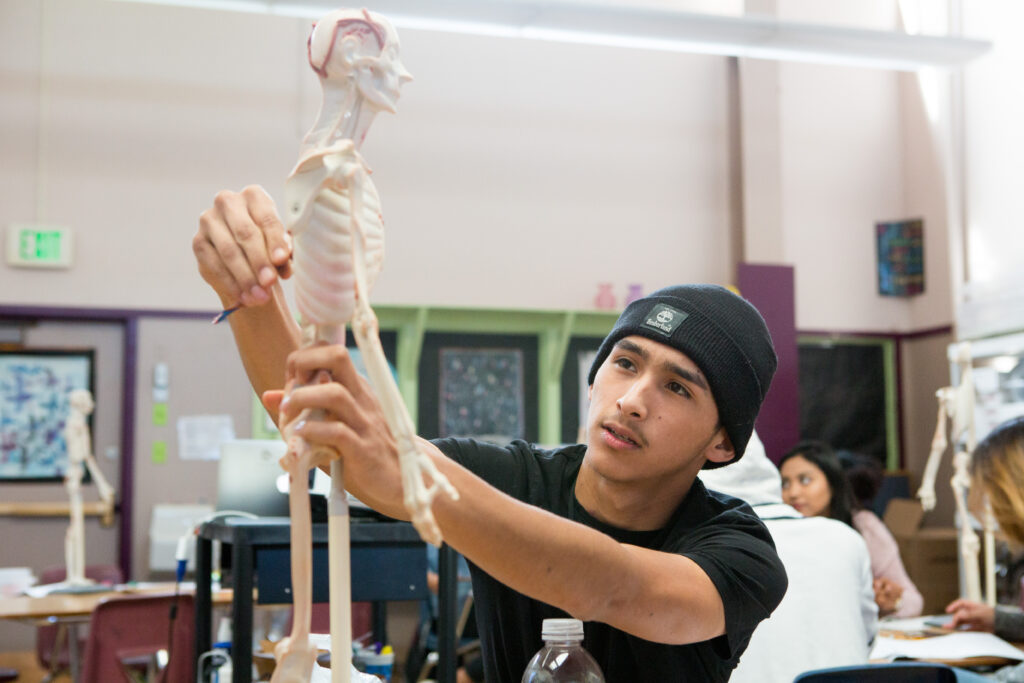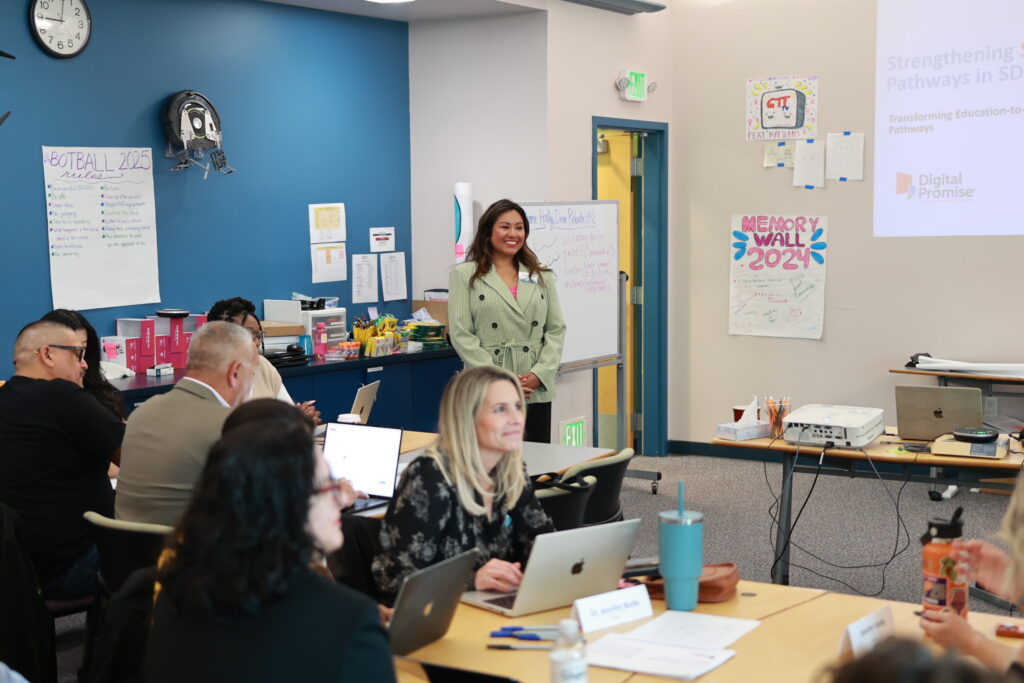
A student in Oakland’s Skyline High School Education and Community Health Pathway sculpts a clay model of the endocrine system.
Credit: Allison Shelley for American Education
Could collaboration between TK-12 schools, colleges and industries improve educational equity and opportunity for the most high-needs learners? California is betting that the answer is yes and is backing that belief up with a $250 million investment in the Regional K-16 Education Collaboratives Grant Program.
The success of California’s nearly 6 million public school students, 60% of whom are low-income, depends on the ability of educators and employers to provide seamless pathways to degrees and careers. This is no small feat and requires a big investment of time, energy and resources.
In 2020, amid the pandemic, 15 education organizations in the Central Valley, including school districts, community colleges and four-year institutions, joined forces to improve dual enrollment and skill-building opportunities and create more equitable pathways to college. The Fresno-Madera K-16 Collaborative has already launched thousands of learners on a path to and through college. Building on the initial success of this effort, the California Department of General Services has invested $250 million in the Regional K-16 Education Collaboratives Grant Program to fund career-oriented pathways and Recovery with Equity recommendations. Nine regional collaboratives received four-year funding in June 2022, and a second-round application to fund additional collaborative regions just closed on Oct. 3.
Too often, innovations in education and workforce development occur in silos, with little support to build a community of practice or align strategy. The goal of the K-16 grant program is to break down these silos and get regional entities working together to advance educational equity and workforce resilience. However, because such regional efforts are relatively new, little research and few resources exist to support them.
From our work supporting educational and workforce partners, here are a few lessons learned:
- Focus on learners and equity. Partners in a regional collaborative are drawn together for one common goal: to advance equity of opportunity for learners. As such, keep learners at the center of all discussions. One suggested principle to guide the collaborative: Consider each student, no matter their age, location, or pathway as our collective responsibility, and use this orientation as a north star in decision-making.
- Ensure balance. The composition of an educational collaborative matters. Representation and equity are essential in making high-stakes decisions — especially regarding dissemination of funding. To ensure the buy-in of partners, consider educational segments, geography and distribution of partners across education and industry. While postsecondary partners often have larger support structures, resources and student populations, the participation of TK-12 districts and county offices of education is crucial to the success of K-16 collaboratives. Thus, TK-12 partners may need additional financial backing to ensure equitable representation and influence.
- Build deep and authentic employer engagement. Strong industry partnerships will drive pathway development in high-needs areas and enhance career education and work-based learning for students. Accomplishing this in a collaborative setting can be challenging. Because the worlds of public education and private industry have historically been separate, businesses/employers must be active participants in meetings and discussions. Talent pipeline management, an approach to workforce development, which positions employers as end customers of education supply chains, may be useful in such collaborations.
- Dedicate staffing. A collaborative must have its own staffing to be effective and sustainable. Initiating a collaborative staffed only by volunteers presents challenges, as members, usually employed full-time, have limited availability. Dedicated staff can maintain momentum and handle daily operations, securing the collaborative’s success. Acknowledging members’ limited availability is essential. Providing support and, if feasible, incentives for participation can enhance engagement.
- Design the funding model to be both equitable and sustainable. How the collaborative divvies up funds is a momentous decision that influences its ability to advance its priorities. Consider where funds will have the greatest impact. For example, while most rural high schools have far smaller head counts than urban high schools, they face greater challenges competing for grant funds and building career programs because of their geographic isolation and limited resources.
Wherever possible, leveraging existing funding toward a common purpose can remove silos and maximize sustained collaborative impact. For example the Community Economic Resilience Fund is a $600 million state grant program designed to promote sustainable, climate-friendly economic development and equitable pandemic recovery. Funds support regional communities in developing coordinated road maps for economic development, with an emphasis on the creation of high-quality jobs in sustainable industries. The CERF regions and timeline intentionally align with those of the K-16 Collaboratives grant program, and the two regional efforts should complement and support one another.
Finally, the K-16 Collaboratives Educational Grant Program expires in 2026, so designing the funding model to be sustainable is critical. In determining how to direct funds, think not only about what pilot initiatives will be sustainable but can provide proof of concept for replication and scalability through future investments.
An adage says, “If you want to go fast, go alone. If you want to go far, go together.”
In a recent panel on diversifying the health care workforce, Freeman Hrabowski, a former educational adviser to President Barack Obama, argued that the single most important policy change he would make would be, “more incentives to have people at different levels of education understanding both the strengths of other levels and the challenges they face. … We need policies that will have more substantive collaboration across levels.”
At every TK-16 school in California, there are bright spots of innovation and individual educators working tirelessly to make sure their students don’t fall through the cracks. Regional collaboration can harness and scale the impact of these individuals to advance systems change.
•••
Annie Sterling is a program manager at Capitol Impact, a Sacramento-based social impact consulting firm, and previously served for more than a decade as an English language arts and social studies teacher in California public schools. Natalie Lenhart, Lex Carlsson and Alex Taghavian of Capitol Impact contributed to this op-ed.
The opinions expressed in this commentary represent those of the author. EdSource welcomes commentaries representing diverse points of view. If you would like to submit a commentary, please review our guidelines and contact us.


